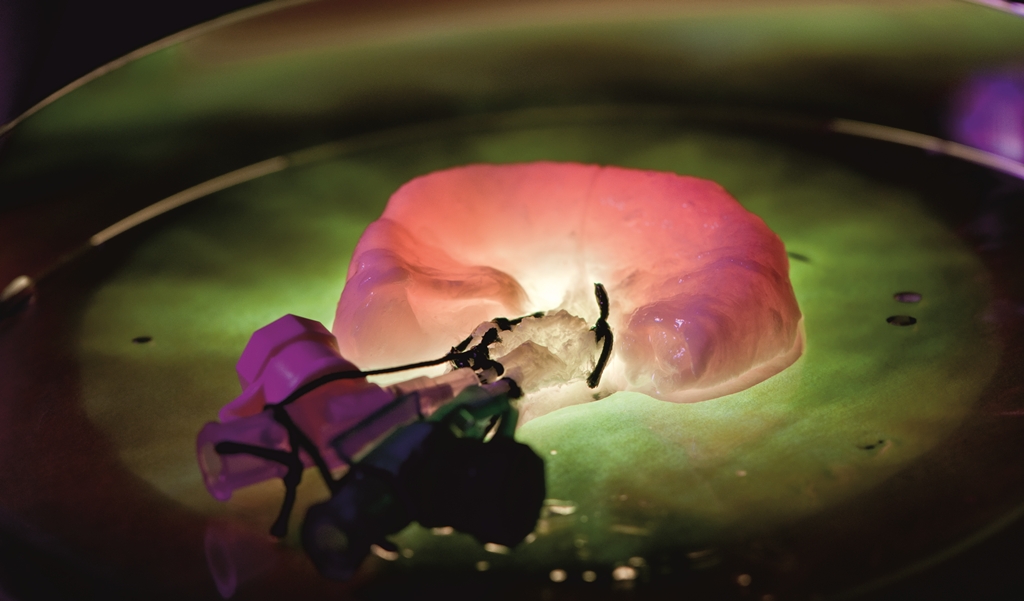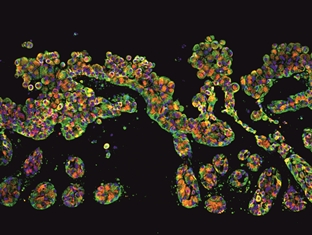Fraunhofer ISC expands Health Unit


The Fraunhofer Institute for Silicate Research ISC significantly expands its research and development activities in Würzburg in the areas of health, medical products and cell-based regenerative therapies. The Translational Center “Regenerative Therapies for Oncology and Musculoskeletal Diseases“, hitherto a branch of the Fraunhofer Institute for Interfacial Engineering and Biotechnology IGB in Stuttgart, became part of the Fraunhofer ISC on 1 August 2017. The Center is headed by Professor Heike Walles and was established at the Würzburg University Hospital. Along with the change of parent institute came a change of name: The former abbreviation “TZKME“ will be “TLC-RT“ instead (for Translational Center Regenerative Therapies). Through the integration of the Translational Center, the Fraunhofer ISC in Würzburg expands by 47 members of staff.
“We want to establish new kinds of therapies based on novel materials and methods which trigger the body’s own healing mechanisms.” This is how Professor Heike Walles describes the objective of the Fraunhofer Translational Center in Würzburg. The center aims to speed up the transfer of research results in materials science and regenerative medicine into clinical application. To achieve this goal, scientists from different academic fields merge their knowledge and know-how in the Translational Center. Natural and life scientists join forces with bio-engineers, physicians and materials researchers to come up with novel solutions in pre-clinical and clinical applications, and all this in close cooperation with med-tech or pharmaceutical companies. Current research focus is on implants and cell therapies e.g. for cartilage and bone replacement or following cancer treatment.
Professor Walles and both her teams at the Translational Center and her Chair for Tissue Engineering and Regenerative Medicine at the Würzburg University Hospital are particularly interested in diseases which cannot be cured with available standard therapies. This is why a close cooperation began to grow with the materials scientists at the Fraunhofer ISC. “Fraunhofer ISC researchers had developed a wound dressing together with an industry partner. This wound dressing triggers the healing of chronic wounds – a regenerative approach which was most attractive for the Translational Center in terms of tissue engineering”, remembers Dr. Jörn Probst, head of the Fraunhofer ISC health unit and adds: “Bio-compatibility is one thing, but it is the special surface structuring of the 3D scaffold material that enables an oriented cell growth in just the right direction so chronic wounds can heal, and this without scars.“
Other starting points for joint research of the Translational Center and the Fraunhofer ISC include the synthesis of biologically or biochemically functionalized particles for use in personalized diagnostics/therapy or regenerative therapy approaches in dental medicine.
The teaming up of the Fraunhofer ISC and the TLC-RT to promote the development of novel cell and cell-tissue based therapies for diseases and dysfunctions of the human body also creates a link to the Würzburg University Hospital. In view of this, Professor Gerhard Sextl, Director of the Fraunhofer ISC, points to a new perspective for health research in Würzburg as a whole: “The resulting line-up will not only strengthen the health unit of the Fraunhofer ISC but is bound to give new impetus to application-driven health research in the entire Würzburg area.” The materials-based R&D of the Fraunhofer ISC will now extend to 3D human in vitro test systems and bioreactors for a rapid and reliable evaluation of new drugs, medicinal products, and therapies. Automated laboratory processes for GMP manufacturing will also play a major part. All this adds up to set the course towards an expedited implementation of new therapies which are urgently awaited by patients everywhere.
Infobox Translational Center Regenerative Therapies TLC-RT
In 2009, Professor Dr. Heike Walles, then working for the Fraunhofer Institute for Interfacial Engineering and Biotechnology IGB, followed a call to the Chair of Tissue Engineering and Regenerative Medicine at the Medical Faculty of the Würzburg University. At the same time she established the Fraunhofer Project Group “Regenerative Medicine for Oncology”. After a positive evaluation in 2014, the Project Group turned into the Translational Center Regenerative Therapies and Musculoskeletal Diseases, funded by the Bavarian State Government. From 2014 onward, Professor Walles managed the Translational Center as a branch of the Fraunhofer IGB. On 1 August 2017, the Center was transferred to the Fraunhofer Institute for Silicate Research ISC and changed its name to “TLC-RT”, short for Translational Center Regenerative Therapies.
Infobox Fraunhofer Institute for Silicate Research ISC
The Fraunhofer Institute for Silicate Research ISC – directed by Prof. Dr. Gerhard Sextl – is a most dynamic application-oriented R&D center. In 2011, the Würzburg-based Institute founded the Fraunhofer Project Group for Materials Recycling and Resource Strategies IWKS at Alzenau and Hanau. The prospering Project Group now has a staff of 90 and continues to grow. The transition of the former Project Group Ceramic Composites to the Fraunhofer Center for High-Temperature Materials and Design HTL in Bayreuth was equally successful, the Center now has a workforce of 100 and specializes in energy- and CO2-saving lightweight materials and processing technologies for mobility, power plant engineering and production. The Fraunhofer activities in battery research, originally located at Würzburg and Garching, were recently merged into one remaining center, now located in Würzburg at the Fraunhofer ISC as the Fraunhofer R&D Center for Electromobility Bavaria FZEB with a staff of over 30 members. The Fraunhofer ISC has thus become one of Germany’s leading R&D centers for materials and technologies in energy and resource efficiency. The integration of the Fraunhofer Translational Center for Regenerative Therapies TLC-RT now boosts the Health unit, another asset of the Fraunhofer ISC.
For more information, please look at our handout of Fraunhofer Translational Center Regenerative Therapies TLC-RT
Last modified: